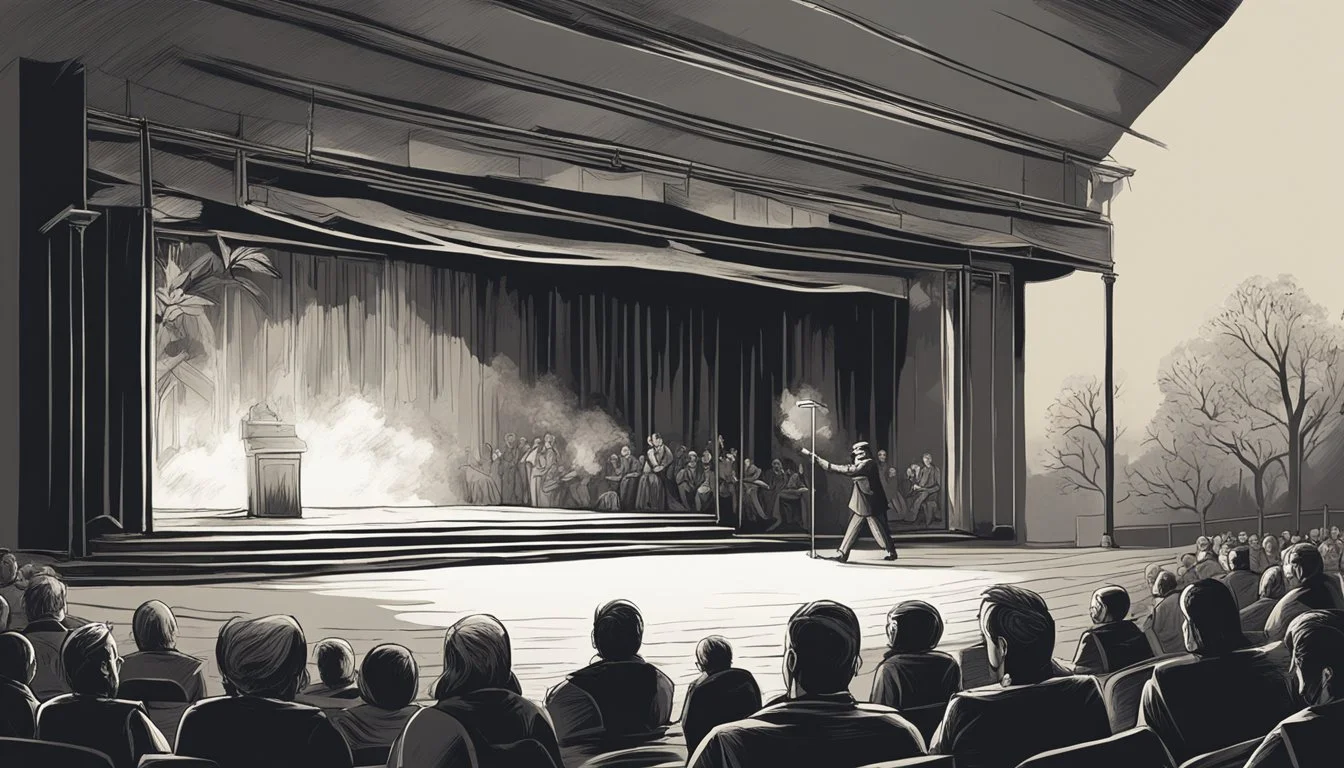The Ethical Implications of Reenactments in American Nightmare
Balancing Education and Sensitivity
Netflix's true crime documentary "American Nightmare" has sparked discussions about the ethical use of reenactments in storytelling. The series explores the 2015 kidnapping of Denise Huskins and the subsequent accusations against her and her boyfriend Aaron Quinn. Through interviews and dramatized scenes, it portrays their struggle to prove their innocence.
Reenactments serve as a powerful tool to engage viewers and illustrate complex events. However, their use raises concerns about potential re-victimization of crime survivors and the blurring of lines between fact and fiction. The Society of Professional Journalists emphasizes the importance of clearly labeling such reconstructions to maintain transparency and ethical integrity.
While reenactments can enhance storytelling, they must be approached with caution. "American Nightmare" balances these elements by incorporating news clips, audio recordings, and footage alongside dramatized scenes. This approach aims to provide a comprehensive view of the case while maintaining respect for the real individuals involved.
Overview of 'American Nightmare'
"American Nightmare" is a Netflix true crime docuseries that explores a complex kidnapping case. The series delves into the investigation, media coverage, and societal implications surrounding the incident.
Origins and True Crime Genre Popularity
True crime content has surged in popularity across various media platforms. Netflix capitalized on this trend by producing "American Nightmare." The series aims to provide an in-depth look at a real criminal case, appealing to viewers' fascination with crime stories.
The true crime genre often blends investigative journalism with storytelling techniques. This approach allows audiences to engage with real-world events while experiencing narrative suspense.
"American Nightmare" follows this format, presenting a compelling case study that highlights issues within the criminal justice system.
Denise Huskins and Aaron Quinn's Case Summary
The docuseries focuses on the 2015 kidnapping of Denise Huskins from her boyfriend Aaron Quinn's home in Vallejo, California. Initially, authorities suspected Quinn of involvement and dismissed Huskins' account as a hoax.
Huskins was held captive for two days before being released. The couple faced public scrutiny and disbelief from law enforcement.
The case took an unexpected turn when the true perpetrator was caught months later. This revelation vindicated Huskins and Quinn, exposing serious flaws in the initial investigation.
Notable Coverage and Media Influence
"American Nightmare" examines the media's role in shaping public perception of the case. News outlets drew parallels to the film "Gone Girl," casting doubt on Huskins' story.
The series uses archival footage and interviews to illustrate how media coverage influenced the investigation. It highlights the power of narratives in criminal cases and their potential to sway public opinion.
By presenting a comprehensive view of the events, "American Nightmare" challenges viewers to reconsider their assumptions about true crime stories and media portrayals of victims.
The Ethical Context of Reenactments
Reenactments in documentaries raise complex ethical questions about truth, representation, and potential psychological impacts. Their use requires careful consideration of authenticity, viewer perception, and effects on subjects.
Dramatic Reenactments in Documentary Filmmaking
Dramatic reenactments aim to visually depict events where actual footage is unavailable. They can help audiences understand complex situations or provide emotional context. However, reenactments blur the line between fact and fiction.
The Society of Professional Journalists' Code of Ethics states reenactments should be "clearly labeled." This helps viewers distinguish between real footage and recreated scenes.
Documentarians must balance storytelling with factual accuracy. Overly dramatized reenactments risk misleading viewers or sensationalizing events. Careful staging and editing are crucial to maintain journalistic integrity.
Psychological Implications of Reenacted Trauma
Reenacting traumatic events can have significant psychological effects on participants and viewers. For crime victims, reliving experiences through reenactments may trigger distress or re-traumatization.
Viewers may also experience secondary trauma from watching graphic reenactments. This raises questions about the necessity and extent of recreating violent or disturbing scenes.
Documentarians must weigh the informational value against potential harm. Consulting mental health professionals can help mitigate risks. Providing content warnings allows viewers to make informed choices about engaging with sensitive material.
Balancing Authenticity and Sensitivity
Achieving a balance between authentic representation and sensitivity to trauma is crucial. Reenactments should strive for accuracy while avoiding exploitation or sensationalism.
Involving subjects in the reenactment process can increase authenticity and give them agency. However, this must be approached carefully to prevent further trauma.
Filmmakers can use creative techniques like stylized reenactments or partial recreations to convey information without graphic depictions. Thoughtful framing and camera angles can maintain impact while minimizing potential harm.
Ethical reenactments require ongoing dialogue between filmmakers, subjects, and mental health experts to ensure responsible portrayal of sensitive events.
Case Profiles
The American Nightmare case involves complex profiles of the perpetrator, law enforcement, and victims. Their interconnected stories reveal critical failings in the justice system's handling of this disturbing crime.
Matthew Muller: The Perpetrator's Background
Matthew Muller, a disbarred lawyer and former Marine, orchestrated the 2015 home invasion and abduction of Denise Huskins. His criminal history included prior break-ins and sexual assaults. Muller's elaborate scheme involved disguises, drugging the victims, and constructing a soundproof room for holding Huskins captive.
Despite his meticulous planning, Muller left crucial evidence at another crime scene. This led to his arrest and eventual conviction. He received a 40-year federal prison sentence for the kidnapping.
Muller's background as a Harvard-educated attorney added a perplexing dimension to the case. It raised questions about how someone with his credentials could commit such heinous acts.
Analyzing Vallejo Police's Handling of the Case
The Vallejo Police Department's response to the kidnapping was marred by skepticism and missteps. Officers initially dismissed Huskins' abduction as a hoax, likening it to the film "Gone Girl." This premature conclusion led to a flawed investigation and public humiliation of the victims.
Law enforcement's errors included:
Failing to properly secure the crime scene
Accusing Aaron Quinn of involvement without evidence
Publicly declaring the kidnapping a hoax before thorough investigation
These mistakes resulted in a $2.5 million settlement paid to Huskins and Quinn by the City of Vallejo. The case exposed serious flaws in the department's investigative procedures and treatment of victims.
Victims' Journey: Denise Huskins and Aaron Quinn
Denise Huskins and Aaron Quinn endured a harrowing ordeal that extended far beyond the initial crime. Huskins was subjected to a traumatic 48-hour captivity, including sexual assault. Quinn faced intense police scrutiny and was initially treated as a suspect.
After Huskins' release, the couple confronted public skepticism fueled by police statements. They fought to clear their names and seek justice. Their persistence led to Muller's arrest and conviction.
The victims' resilience was evident in their pursuit of legal action against the Vallejo Police Department. Their $2.5 million settlement highlighted the need for improved law enforcement practices in handling sensitive cases.
Comparative Analysis
American Nightmare's use of reenactments draws parallels to other true crime media, highlighting both similarities and differences in storytelling approaches and public reactions.
Gone Girl: Media Comparisons and Public Perception
The Denise Huskins case earned the moniker "real-life Gone Girl" due to striking similarities with Gillian Flynn's novel and David Fincher's film adaptation. Both narratives feature a woman's disappearance initially viewed with skepticism by authorities.
Rosamund Pike's portrayal of Amy Dunne in Gone Girl mirrors the media's initial perception of Huskins. The public and law enforcement's rush to judgment in both cases underscores the power of confirmation bias.
Unlike Gone Girl's fictional twist, Huskins's ordeal was tragically real. American Nightmare's reenactments serve to validate her experience, contrasting with the film's use of unreliable narration.
Other Notable Reenactments in True Crime Media
True crime documentaries increasingly employ reenactments to engage viewers and provide visual context. The Tinder Swindler used dramatizations to illustrate victims' accounts of romance scams, enhancing emotional impact.
American Nightmare's approach differs by focusing reenactments on the victims' perspective, avoiding sensationalism. This technique aims to foster empathy and understanding rather than exploit the crime for entertainment.
Reenactments in true crime media walk a fine line between illumination and potential exploitation. American Nightmare attempts to balance these concerns by using restrained dramatizations to support the victims' narrative and challenge preconceived notions.
Legal and Societal Repercussions
The Denise Huskins case exposed critical flaws in law enforcement practices and the justice system, leading to significant consequences for individuals and institutions involved.
Impact on Vallejo and Broader Communities
Vallejo, California faced intense scrutiny following the mishandling of the Huskins case. The city's reputation suffered as national media coverage highlighted the police department's missteps.
Public trust in local law enforcement eroded, sparking demands for accountability and reform. The case became a catalyst for discussions on police training and investigative procedures across the country.
Community members in Vallejo organized protests and town halls, calling for changes in police leadership and practices. The incident strained relationships between residents and law enforcement, creating lasting tensions.
The Role of Law Enforcement and Judicial Reflections
The Vallejo Police Department faced severe criticism for their rushed judgment and accusatory stance towards Huskins and Quinn. This case exposed weaknesses in investigative protocols and interrogation techniques.
Several officers involved in the case faced internal reviews and disciplinary actions. The department implemented new training programs focused on victim sensitivity and thorough evidence evaluation.
The justice system also came under fire for its initial skepticism of the victims' accounts. Judges and prosecutors reassessed their approaches to similar cases, emphasizing the importance of presuming innocence and thoroughly investigating all claims.
Compensation and Acknowledgment of Mistakes
Huskins and Quinn filed a federal lawsuit against the city of Vallejo and its police department. The case resulted in a $2.5 million settlement, acknowledging the mistakes made by law enforcement.
This settlement set a precedent for similar cases, emphasizing the importance of proper police conduct and the consequences of false accusations. The compensation aimed to address the emotional trauma and reputational damage suffered by the couple.
Vallejo officials issued a formal apology to Huskins and Quinn, admitting to the mishandling of the investigation. This public acknowledgment marked a significant step towards accountability and healing for the victims and the community.
Personal Narratives and Public Response
Reenactments in "American Nightmare" sparked debates about media ethics, survivor experiences, and public perceptions of criminal cases. The documentary's approach raised questions about responsibility in storytelling and the impact on those involved.
The Public's Role in Trial by Media
Media coverage significantly shaped public opinion of the Dodge County case. News reports and social media discussions created a digital courtroom where facts mixed with speculation. This informal trial by media influenced local sentiment and put pressure on law enforcement.
Public engagement ranged from support for the victims to skepticism about their claims. Online forums became battlegrounds of conflicting narratives. The case highlighted how public discourse can impact ongoing investigations and legal proceedings.
Felicity Morris, Bernadette Higgins, and Crafting Narratives
Felicity Morris and Bernadette Higgins faced the challenge of presenting a complex case sensitively. Their directorial choices in "American Nightmare" aimed to balance factual reporting with compelling storytelling.
The filmmakers used reenactments to visualize key events, a decision that drew both praise and criticism. Morris and Higgins sought to give voice to the survivors while maintaining journalistic integrity. Their approach sparked discussions about the line between documentation and dramatization in true crime narratives.
Survivors' Rights and the Ethics of Storytelling
The documentary raised important questions about survivors' agency in sharing their stories. Ethical concerns emerged regarding consent and the potential for retraumatization through reenactments.
Advocates emphasized the need for trauma-informed practices in media productions. The filmmakers' responsibility to protect survivors while pursuing truth became a central topic of debate.
Critics questioned whether the public's right to know outweighed potential harm to those involved. The case underscored the delicate balance between raising awareness and respecting survivors' privacy.
Conclusion
Reenactments in true crime documentaries like American Nightmare raise complex ethical questions. They can powerfully illustrate victims' experiences and highlight investigative failures. Yet concerns remain about potential sensationalism and re-traumatization.
Careful consideration of consent, accuracy, and sensitivity is crucial. Filmmakers must balance storytelling with respect for those involved. Ethical reenactments require thorough research and consultation with experts.
Viewers should approach reenactments critically, recognizing their constructed nature. While they can build empathy, reenactments should not be seen as definitive truth. Their primary value lies in complementing factual evidence and firsthand accounts.
The use of reenactments in American Nightmare sparked important discussions about true crime ethics. It underscored the need for responsible storytelling that prioritizes accuracy and victims' perspectives.
As the genre evolves, ongoing dialogue between creators, subjects, and audiences is essential. This will help shape ethical standards for depicting real-life traumas respectfully and meaningfully in visual media.






